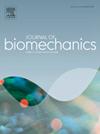What about the mechanical behaviour and modelling of arteries in radial direction?
IF 2.4
3区 医学
Q3 BIOPHYSICS
引用次数: 0
Abstract
Understanding the physiological behaviour of arteries in the radial direction is crucial for establishing a reference point to detect and analyse pathological changes. In this study, the influence of the radial component of the aorta will be investigated by performing experimental tests on porcine aortic tissue in the three main directions of the aorta: circumferential, longitudinal and radial. The results obtained in all directions will be analysed and compared in order to contribute to a comprehensive understanding of the healthy behaviour of the vessel.
Our results demonstrate that the aorta exhibits nonlinear behaviour under compression and tensile loading in the radial direction. Moreover, tissue stiffening progresses more prominently under compression compared to tensile loading. We have found that the tensile stiffness in the ATA is higher compared to the other two regions examined. The Neo-Hookean and Demiray models were selected to describe the isotropic contribution when fitting the uniaxial response of the circumferential and longitudinal samples using the GOH model. Neo-Hookean model fall short () in accurately replicating the observed behaviour of the aorta in the radial direction and Demiray model showing better fitting results ().
求助全文
约1分钟内获得全文
求助全文
来源期刊

Journal of biomechanics
生物-工程:生物医学
CiteScore
5.10
自引率
4.20%
发文量
345
审稿时长
1 months
期刊介绍:
The Journal of Biomechanics publishes reports of original and substantial findings using the principles of mechanics to explore biological problems. Analytical, as well as experimental papers may be submitted, and the journal accepts original articles, surveys and perspective articles (usually by Editorial invitation only), book reviews and letters to the Editor. The criteria for acceptance of manuscripts include excellence, novelty, significance, clarity, conciseness and interest to the readership.
Papers published in the journal may cover a wide range of topics in biomechanics, including, but not limited to:
-Fundamental Topics - Biomechanics of the musculoskeletal, cardiovascular, and respiratory systems, mechanics of hard and soft tissues, biofluid mechanics, mechanics of prostheses and implant-tissue interfaces, mechanics of cells.
-Cardiovascular and Respiratory Biomechanics - Mechanics of blood-flow, air-flow, mechanics of the soft tissues, flow-tissue or flow-prosthesis interactions.
-Cell Biomechanics - Biomechanic analyses of cells, membranes and sub-cellular structures; the relationship of the mechanical environment to cell and tissue response.
-Dental Biomechanics - Design and analysis of dental tissues and prostheses, mechanics of chewing.
-Functional Tissue Engineering - The role of biomechanical factors in engineered tissue replacements and regenerative medicine.
-Injury Biomechanics - Mechanics of impact and trauma, dynamics of man-machine interaction.
-Molecular Biomechanics - Mechanical analyses of biomolecules.
-Orthopedic Biomechanics - Mechanics of fracture and fracture fixation, mechanics of implants and implant fixation, mechanics of bones and joints, wear of natural and artificial joints.
-Rehabilitation Biomechanics - Analyses of gait, mechanics of prosthetics and orthotics.
-Sports Biomechanics - Mechanical analyses of sports performance.
 求助内容:
求助内容: 应助结果提醒方式:
应助结果提醒方式:


